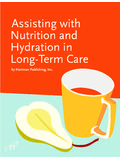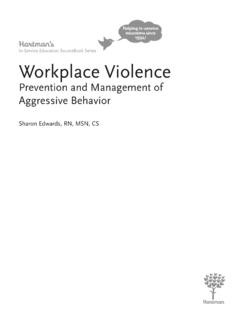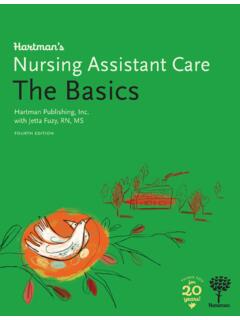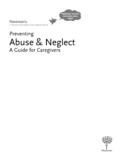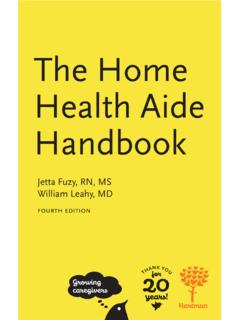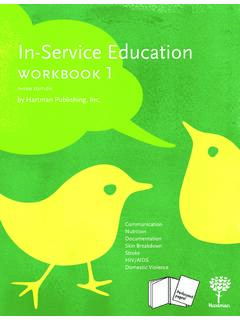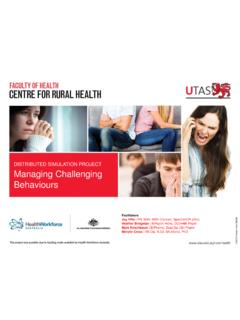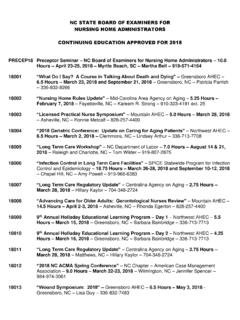Transcription of Providing Home Care - hartmanonline.com
1 Providing home CareA Textbook for home Health AidesWilliam Leahy, MDwith Jetta Fuzy, RN, MSand Julie Grafe, RN, BSNfifth editionCreditsManaging Editor Susan Alvare HedmanDesigner Kirsten BrowneCover Illustrator Jo TroncProduction Manager Thad CastilloPhotography Matt Pence Pat Berrett Art Clifton Dick RuddyProofreaders Kristin Calderon Kristin Cartwright Joanna OwusuSales/Marketing Deborah Rinker Kendra Robertson Erika Walker Belinda Midyette Carol CastilloCustomer Service Fran Desmond Thomas Noble Angela Storey Eliza Martin Col FoleyCopyright Information 2017 by Hartman Publishing, Inc. 1313 Iron Ave SW Albuquerque, New Mexico 87102 (505) 291-1274 web: email: Twitter: @HartmanPubAll rights reserved. No part of this book may be reproduced, in any form or by any means, without permission in writing from the 978-1- 60425- 067-1 PRINTED IN CANADAN otice to ReadersThough the guidelines and procedures contained in this text are based on consultations with healthcare profession-als, they should not be considered absolute recommenda-tions.
2 The instructor and readers should follow employer, local, state, and federal guidelines concerning healthcare practices. These guidelines change, and it is the reader s re-sponsibility to be aware of these changes and of the policies and procedures of his or her healthcare publisher, author, editors, and reviewers cannot accept any responsibility for errors or omissions or for any conse-quences from application of the information in this book and make no warranty, express or implied, with respect to the contents of the book. The publisher does not warrant or guarantee any of the products described herein or perform any analysis in connection with any of the product informa-tion contained UsageThis textbook utilizes the pronouns he, his, she, and hers interchangeably to denote healthcare team members and clients. iiAcknowledgmentsAll books need an author. Finding one who is passionate and knowledgeable is a publisher s most important work.
3 William Leahy, MD became involved with home health aide education both out of an interest in the care that his patients received and to give direction and meaning to the lives of young people in his community. After teaching the home health aide program at Bladensburg High School in suburban Maryland, he undertook the project of writing a better book. To his credit, he hired a registered nurse, working as a professional health jour-nalist, to help craft the project. His vision was to produce learning and teaching materials that could be used by the program he founded and subsequently, to use the royalties from the project to ensure the program s continu-ance. All royalties from sales of this book fund a foundation formed to support young people studying for health- care educational material for unlicensed healthcare workers demands the guidance of nurses who under-stand both educational theory and the practice of home health aide services.
4 We found both in our experienced consulting editors, Jetta Fuzy, RN, MS, and Julie Grafe, RN, the years of creating and revising this text, many reviewers and customers guided us. A sincere thanks to each of them who helped us with this most recent edition:Theresa J. DeBon, RN, BS Tulsa, OKBrenda L. Howe, MSN-NEd, RN Bend, OR Charles Illian, BSN, RN Orlando, FLNelson Wood, BSN, RN New Hartford, NYWe are very appreciative of the many sources who shared their informative photos with us: Briggs Corporation Dreamstime Exergen Corporation Harrisburg Area Community College Hollister Incorporated Invacare Corporation Medline Industries National Pressure Ulcer Advisory Panel North Coast Medical, Inc. Nova Medical Products RG Medical Diagnostics of Wixom, MI Vancare, Inc. Welch AllyniiiSection Iunderstanding home health aide services1 home care and the Healthcare System1. Describe the structure of the healthcare system and describe ways it is changing 12.
5 Explain Medicare and Medicaid, and list when Medicare recipients may receive home care 33. Explain the purpose of and need for home health care 34. List key events in the history of home care services 45. Identify the basic methods of payment for home health services 56. Describe a typical home health agency 67. Explain how working for a home health agency is different from working in other types of facilities 62 The home Health Aide and the care Team1. Identify the role of each care team member 92. Describe the role of the home health aide and explain typical tasks performed 113. Identify tasks outside the scope of practice for home health aides 124. Define the client care plan and explain its purpose 125. Describe how each team member contributes to the care plan 136. List the federal regulations that apply to home health aides 157. Describe the purpose of the chain of command 158.
6 Define policies and procedures and explain why they are important 169. List examples of a professional relationship with a client and an employer 1710. Demonstrate how to organize care assignments 1811. Demonstrate proper personal grooming habits 1912. Identify personal qualities a home health aide must have 1913. Identify an employer s responsibilities 203 Legal and Ethical Issues1. Define the terms ethics and laws and list examples of legal and ethical behavior 222. Explain clients rights and discuss why they are important 233. List ways to recognize and report elder abuse and neglect 264. List examples of behavior supporting and promoting clients rights 275. Explain HIPAA and list ways to protect clients confidentiality 286. Discuss and give examples of advance directives 307. Identify community resources available to help the elderly 30 Section IIbuilding a foundation: before client care4 Communication and Cultural Diversity1.
7 Define communication 322. Explain verbal and nonverbal communication 333. Identify barriers to communication 344. List ways to make communication accurate and complete and explain how to develop effective interpersonal relationships 355. Describe the difference between facts and opinions 376. Describe basic medical terminology and approved abbreviations 387. Explain how to give and receive an accurate oral report of a client s status 39 Learning ObjectivePagePageivContents8. Explain objective and subjective information and describe how to observe and report accurately 409. Explain why documentation is important and describe how to document visit records and incident reports 4110. Demonstrate the ability to use verbal and written information to assist with the care plan 4311. Demonstrate effective communication on the telephone 4412.
8 Describe cultural diversity and religious differences 4413. List examples of cultural and religious differences 4714. List ways of coping with combative behavior 4715. List ways of coping with inappropriate behavior 485 Infection Prevention and Standard Precautions1. Define infection prevention and explain the chain of infection 502. Explain Standard Precautions 513. Define hand hygiene and identify when to wash hands 534. Identify when to use personal protective equipment (PPE) 555. Explain how to handle spills 596. Explain Transmission-Based Precautions 597. Explain sterilization and disinfection 618. Explain how bloodborne diseases are transmitted 629.
9 Explain the basic facts regarding HIV and hepatitis infection 6310. Identify high-risk behaviors that allow the spread of HIV 6411. Demonstrate knowledge of the legal aspects of HIV, including testing 6512. Identify community resources and services available to clients with HIV or AIDS 6513. Explain tuberculosis and list infection prevention guidelines 6514. Explain the importance of reporting a possible exposure to an airborne or bloodborne disease 6615. Discuss MRSA, VRE, and C. diff icile 6716. List employer and employee responsibilities for infection prevention 686 Safety and Body Mechanics1. Explain the principles of body mechanics 702. Apply principles of body mechanics to daily activities 713. List ways to adapt the home to principles of proper body mechanics 724. Identify five common types of accidents in the home 735. List home fire safety guidelines and describe what to do in case of fire 786.
10 Identify ways to reduce the risk of automobile accidents 807. Identify guidelines for using a car on the job 808. Identify guidelines for working in high-crime areas 817 Emergency care and Disaster Preparation1. Demonstrate how to recognize and respond to medical emergencies 832. Demonstrate knowledge of first aid procedures 843. Identify emergency evacuation procedures 914. Demonstrate knowledge of disaster procedures 92 Section IIIa holistic approach to understanding clients8 Physical, Psychological, and Social Health1. Identify basic human needs 952. Define holistic care 97 Learning ObjectiveLearning ObjectivePagePagevLearning ObjectiveLearning ObjectivePagePagevi3. Identify ways to help clients meet their spiritual needs 984. Discuss family roles and their significance in health care 995.

